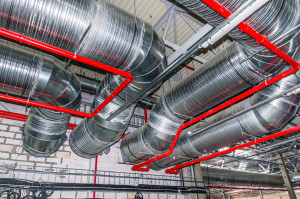
Pipes and other engineering services in industrial building
Dampers make up a critical part of HVAC systems and getting the selection right is vital to long term performance. Here’s what you need to know to choose the right damper.
The basics
Dampers are used to control airflow through certain portions of an HVAC system. You may need them to open and close or you may need them to modulate for variable airflow. They may be duct-mounted, wall-mounted or integrated into air handling equipment. Specialized dampers like smoke dampers limit the spread of smoke through ductwork and air transfer openings.
Dampers are constructed from metal (aluminum or steel) and consist of a frame and moving blades. The position of these blades determines how much air can flow through. Dampers may be have parallel or opposed blade arrangements. Parallel blade dampers are better suited to open/close applications while opposed blade dampers work well for modulating airflow.
Sizing and selecting a damper
Sizing a damper begins with the maximum airflow through the damper using the equation:
Airflow = Velocity x Cross-sectional area.
For dampers, the cross sectional area is the free area, which is the area available for air to flow when the damper is fully opened. Manufacturers publish this information in charts. Once you calculate your free area for a given velocity, use these charts to find the height and width for your damper.
To ensure that the dampers don’t create airflow problems in your system, the fan must be able to overcome the damper pressure drop. Depending on the situation, you may have to oversize your damper to reduce the pressure drop.

Fire damper for fire protection system on the roofing floor.
Choosing a velocity to size the damper depends on the application. The velocity for intake should be limited to 450-500 feet per minute (fpm) to prevent rain from entering. Exhaust velocities can go up to 1200 fpm.
Another decision you have to make when selecting a damper is whether the blades need to be weather-sealed or insulated. Weather sealed and insulated dampers are suitable for intake and exhaust dampers that are open to the exterior.
Controls
Dampers can be manual or automatic and with the increase in building automation, getting control right is important. This is where actuators come in. Our next article will discuss actuators in more detail.
Tags :
actuated valves , Air Flow Rate , Electric Actuators , energy efficient , ENOLGASUSABLOG , Flow Rate , renewable energy , water construction , water security